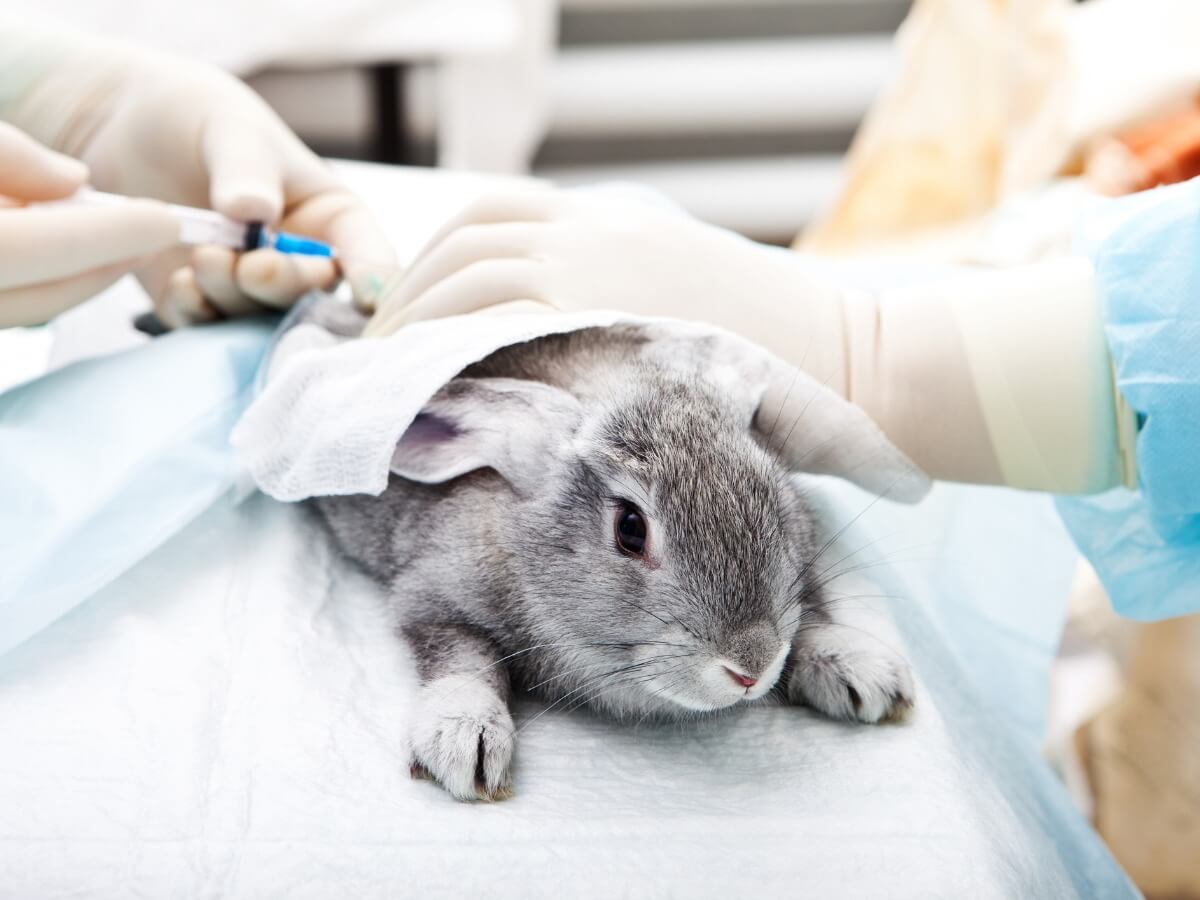Diseases Transmitted by Rabbits

These lovely animals have become wildly popular in homes. However, the knowledge on how to prevent diseases transmitted by rabbits isn’t as extensive as in the case of dogs and cats.
Therefore, the first step to preventing problems when having these pets will be to get to know the most common zoonoses and how they can be spread. In this article, you’ll find tips on prevention in this matter, so keep an eye on the entire article.
What are the diseases transmitted by rabbits?
There are several types of diseases that you can get from having contact with a rabbit. Here you will find them classified according to the infectious agent that causes them, that is viral, fungal, bacterial and parasitic pathologies.
Diseases caused by parasites
In general, if rabbits don’t go outside and are in optimal hygiene conditions, they shouldn’t get any parasites. However, if they do get them, they can transmit a series of diseases:
- Cheyletiellosis: Cheyletiella parasotivorax is a very contagious mite, capable of also infecting humans, although it usually disappears on its own in about 3 weeks. It produces localized dermatitis and itching. This mite is known as “walking dandruff” because sometimes it’s possible to see it directly moving through the fur.
- Giardiasis: Giardia duodenalis is a flagellated protozoan that lodges in the intestinal tract of the animal, producing continuous diarrhea. It doesn’t affect humans unless they’re immunosuppressed, but diarrhea in a rabbit can be fatal if it isn’t treated in time.
- Leishmaniasis: Rabbits can act as an asymptomatic reservoir for Leishmania infantum, but a sandfly mosquito needs to bite the rabbit and then a person in order to infect them. In humans, leishmaniasis causes difficulties in breathing and swallowing, ulcers on the skin, mouth, and lips, congestion and nosebleeds, fever, fatigue, weakness, loss of appetite, and cold sweats.
- Coccidiosis: Coccidia are protozoa that live mainly in the digestive system. They can cause diarrhea (sometimes bloody), intestinal inflammation, and dehydration. They’re transmitted to humans through the handling of feces.
- Microsporidiosis: Encephalitozoon cuniculi is easy to recognize because it leaves rabbits with their heads on one side, as it causes vestibular syndrome. In humans, it also affects the nervous system, mainly the brain (and kidneys).

Diseases transmitted by rabbits caused by fungi
Many of the fungi that rabbits contract can be transmitted to humans, usually through direct contact with the spores. In addition, they’re often difficult to eradicate at home. The most common fungal diseases are 2:
- Ringworm: This disease is contracted by coming into contact with the spores of dermatophyte fungi of the Microsporum and Trichophyton genera. The alopecia that this fungus produces in animals is characteristic, as it’s circular in shape. In humans, it causes circular irritations that cause great itching. It’s very difficult to eradicate ringworm spores from a home.
- Sporotrichosis: The Sporothrix schenckii fungus in humans produces skin nodules that spread through the lymphatic pathways to become abscesses and ulcers. It has a very rare form that affects the lungs and is fatal.
Bacterial diseases
This is where most of the diseases that rabbits transmit to humans are found. The main contagion factor is through direct contact with the animal or by the oral-fecal route. Here are the most common bacterial diseases in this area:
- Melioidosis: Burkholderia pseudomallei bacteria cause abscesses in the organs in which it resides. The most common sites are the lungs, spleen, liver, and adjacent nodes.
- Campylobacteriosis: Campylobacter jejuni symptoms are usually mild. It consists of diarrhea, abdominal pain, and fever that usually last no more than a week. It is commonly confused with gastroenteritis.
- Salmonellosis: Bacteria of the genus Salmonella are very rare in rabbits, but there are cases of zoonoses. These pathogens cause gastroenteritis, vomiting, diarrhea, abdominal pain, and fever.
- Pasteurellosis: Caused by the bacterium Pasteurella multocida, it’s transmitted to humans through bites or scratches. The picture is characterized by the rapid formation of cellulite, with or without abscesses. Wounds appear that exude blood and pus and can affect the bones. In people with respiratory system problems, it causes pneumonia, bronchitis, and lung abscesses.
- Yersiniosis: The bacterium Yersinia pseudotuberculosis causes a serious condition in humans consisting of enterocolitis, diarrhea, fever, and abdominal pain. If the infection progresses, it can create liver and splenic abscesses, osteomyelitis, meningitis, and endocarditis.
- Tetanus: This is transmitted by coming into contact with open wounds or with scratches and bites that go through the skin. The bacterium that causes it is Clostridium tetani and it affects the nervous system, which can lead to death.
- Tularemia: Also known as “rabbit fever”, it’s a disease that’s rarely transmitted to humans. It’s caused by the bacterium Francisella tularensis and produces different symptoms depending on the route of entry, although the most common are pain in the affected area, enlargement of the spleen and liver, coughing, pharyngitis, and skin lesions.
- Q fever: Coxiella burnetii is the agent that causes fever in wild rabbits mainly. In addition to this hyperthermia, in humans it can cause fatigue, chills, headache, abdominal discomfort, nausea, vomiting, or diarrhea.
Viral diseases
There aren’t many diseases that rabbits transmit through viruses. Perhaps the most common in this area is Arenavirus, which causes lymphocytic choriomeningitis. It’s transmitted through the feces and, if it produces symptoms, these consist of fever, encephalitis, or meningitis. If a pregnant woman is infected, it causes malformations and even fetal death.
Prevention for diseases transmitted by rabbits
It is rare for a rabbit to transmit a disease to you. In general, those that affect these mammals the most (such as myxomatosis or viral hemorrhagic disease) are exclusive to this species. However, prevention never hurts to avoid troubles. Here are some tips:
- Keep vaccinations and deworming of rabbits up to date.
- Control feces: Changes in the stool of rabbits give a lot of useful information. The shape, quantity, color, or presence of cecotropes are aspects to watch out for when determining whether the lagomorph could be sick.
- Don’t wait to go to the vet: Rabbits hide the symptoms of their diseases until they’re very sick. At any obvious sign, call your vet immediately.
- Check their fur periodically: Rabbits have very thick fur and it’s difficult to check it. To check for fungi, parasites, and other skin conditions, check your pet often.
- Keep your environment clean and disinfected: Daily hygiene is essential to prevent the accumulation of pathogens. This is especially important if different species coexist in the same space.
- Take care of your own hygiene: Since you have to handle potentially infectious remains, always wash your hands after touching your rabbit or cleaning its area.

To conclude, you’ll have observed that we’ve only spoken about zoonosis between rabbits and humans and not of other species. Covering communicable diseases between different animals is unattainable in a single article. Therefore, before acquiring a rabbit, consult with your veterinarian about what dangers there may be for you and for the other non-human companions you have.
These lovely animals have become wildly popular in homes. However, the knowledge on how to prevent diseases transmitted by rabbits isn’t as extensive as in the case of dogs and cats.
Therefore, the first step to preventing problems when having these pets will be to get to know the most common zoonoses and how they can be spread. In this article, you’ll find tips on prevention in this matter, so keep an eye on the entire article.
What are the diseases transmitted by rabbits?
There are several types of diseases that you can get from having contact with a rabbit. Here you will find them classified according to the infectious agent that causes them, that is viral, fungal, bacterial and parasitic pathologies.
Diseases caused by parasites
In general, if rabbits don’t go outside and are in optimal hygiene conditions, they shouldn’t get any parasites. However, if they do get them, they can transmit a series of diseases:
- Cheyletiellosis: Cheyletiella parasotivorax is a very contagious mite, capable of also infecting humans, although it usually disappears on its own in about 3 weeks. It produces localized dermatitis and itching. This mite is known as “walking dandruff” because sometimes it’s possible to see it directly moving through the fur.
- Giardiasis: Giardia duodenalis is a flagellated protozoan that lodges in the intestinal tract of the animal, producing continuous diarrhea. It doesn’t affect humans unless they’re immunosuppressed, but diarrhea in a rabbit can be fatal if it isn’t treated in time.
- Leishmaniasis: Rabbits can act as an asymptomatic reservoir for Leishmania infantum, but a sandfly mosquito needs to bite the rabbit and then a person in order to infect them. In humans, leishmaniasis causes difficulties in breathing and swallowing, ulcers on the skin, mouth, and lips, congestion and nosebleeds, fever, fatigue, weakness, loss of appetite, and cold sweats.
- Coccidiosis: Coccidia are protozoa that live mainly in the digestive system. They can cause diarrhea (sometimes bloody), intestinal inflammation, and dehydration. They’re transmitted to humans through the handling of feces.
- Microsporidiosis: Encephalitozoon cuniculi is easy to recognize because it leaves rabbits with their heads on one side, as it causes vestibular syndrome. In humans, it also affects the nervous system, mainly the brain (and kidneys).

Diseases transmitted by rabbits caused by fungi
Many of the fungi that rabbits contract can be transmitted to humans, usually through direct contact with the spores. In addition, they’re often difficult to eradicate at home. The most common fungal diseases are 2:
- Ringworm: This disease is contracted by coming into contact with the spores of dermatophyte fungi of the Microsporum and Trichophyton genera. The alopecia that this fungus produces in animals is characteristic, as it’s circular in shape. In humans, it causes circular irritations that cause great itching. It’s very difficult to eradicate ringworm spores from a home.
- Sporotrichosis: The Sporothrix schenckii fungus in humans produces skin nodules that spread through the lymphatic pathways to become abscesses and ulcers. It has a very rare form that affects the lungs and is fatal.
Bacterial diseases
This is where most of the diseases that rabbits transmit to humans are found. The main contagion factor is through direct contact with the animal or by the oral-fecal route. Here are the most common bacterial diseases in this area:
- Melioidosis: Burkholderia pseudomallei bacteria cause abscesses in the organs in which it resides. The most common sites are the lungs, spleen, liver, and adjacent nodes.
- Campylobacteriosis: Campylobacter jejuni symptoms are usually mild. It consists of diarrhea, abdominal pain, and fever that usually last no more than a week. It is commonly confused with gastroenteritis.
- Salmonellosis: Bacteria of the genus Salmonella are very rare in rabbits, but there are cases of zoonoses. These pathogens cause gastroenteritis, vomiting, diarrhea, abdominal pain, and fever.
- Pasteurellosis: Caused by the bacterium Pasteurella multocida, it’s transmitted to humans through bites or scratches. The picture is characterized by the rapid formation of cellulite, with or without abscesses. Wounds appear that exude blood and pus and can affect the bones. In people with respiratory system problems, it causes pneumonia, bronchitis, and lung abscesses.
- Yersiniosis: The bacterium Yersinia pseudotuberculosis causes a serious condition in humans consisting of enterocolitis, diarrhea, fever, and abdominal pain. If the infection progresses, it can create liver and splenic abscesses, osteomyelitis, meningitis, and endocarditis.
- Tetanus: This is transmitted by coming into contact with open wounds or with scratches and bites that go through the skin. The bacterium that causes it is Clostridium tetani and it affects the nervous system, which can lead to death.
- Tularemia: Also known as “rabbit fever”, it’s a disease that’s rarely transmitted to humans. It’s caused by the bacterium Francisella tularensis and produces different symptoms depending on the route of entry, although the most common are pain in the affected area, enlargement of the spleen and liver, coughing, pharyngitis, and skin lesions.
- Q fever: Coxiella burnetii is the agent that causes fever in wild rabbits mainly. In addition to this hyperthermia, in humans it can cause fatigue, chills, headache, abdominal discomfort, nausea, vomiting, or diarrhea.
Viral diseases
There aren’t many diseases that rabbits transmit through viruses. Perhaps the most common in this area is Arenavirus, which causes lymphocytic choriomeningitis. It’s transmitted through the feces and, if it produces symptoms, these consist of fever, encephalitis, or meningitis. If a pregnant woman is infected, it causes malformations and even fetal death.
Prevention for diseases transmitted by rabbits
It is rare for a rabbit to transmit a disease to you. In general, those that affect these mammals the most (such as myxomatosis or viral hemorrhagic disease) are exclusive to this species. However, prevention never hurts to avoid troubles. Here are some tips:
- Keep vaccinations and deworming of rabbits up to date.
- Control feces: Changes in the stool of rabbits give a lot of useful information. The shape, quantity, color, or presence of cecotropes are aspects to watch out for when determining whether the lagomorph could be sick.
- Don’t wait to go to the vet: Rabbits hide the symptoms of their diseases until they’re very sick. At any obvious sign, call your vet immediately.
- Check their fur periodically: Rabbits have very thick fur and it’s difficult to check it. To check for fungi, parasites, and other skin conditions, check your pet often.
- Keep your environment clean and disinfected: Daily hygiene is essential to prevent the accumulation of pathogens. This is especially important if different species coexist in the same space.
- Take care of your own hygiene: Since you have to handle potentially infectious remains, always wash your hands after touching your rabbit or cleaning its area.

To conclude, you’ll have observed that we’ve only spoken about zoonosis between rabbits and humans and not of other species. Covering communicable diseases between different animals is unattainable in a single article. Therefore, before acquiring a rabbit, consult with your veterinarian about what dangers there may be for you and for the other non-human companions you have.
All cited sources were thoroughly reviewed by our team to ensure their quality, reliability, currency, and validity. The bibliography of this article was considered reliable and of academic or scientific accuracy.
- Macías Herrera, G., & Heuze de Icaza, Y. (2005). El conejo como huésped en la transmisión de la encefalitozoonosis por Encephalitozoon cuniculi. Sociedades rurales, producción y medio ambiente, 5(11), 26-30.
- Kötsche, W., & Gottschalk, C. (1974). Enfermedades del conejo y de la liebre (No. SF997. R2. K67 1974.). Editorial Acribia.
- Harwood, D. G. (1990). Infección por Salmonella typhimurium en una granja de conejos. Cunicultura, 15(83), 0029-29.
- Bassols, J., Fernández, A., Gracia, E., & Villa, A. (2004). Etiología de las diarreas en conejos. Boletín de cunicultura lagomorpha, (131), 20-26.
- van den Berg Elipe, N. M., Martínez, M. V., Sifres, M. V., & Martínez, L. S. (2020). Pasteurelosis en el conejo y la influencia de las condiciones ambientales. Boletín de cunicultura lagomorpha, (198), 28-32.
This text is provided for informational purposes only and does not replace consultation with a professional. If in doubt, consult your specialist.








